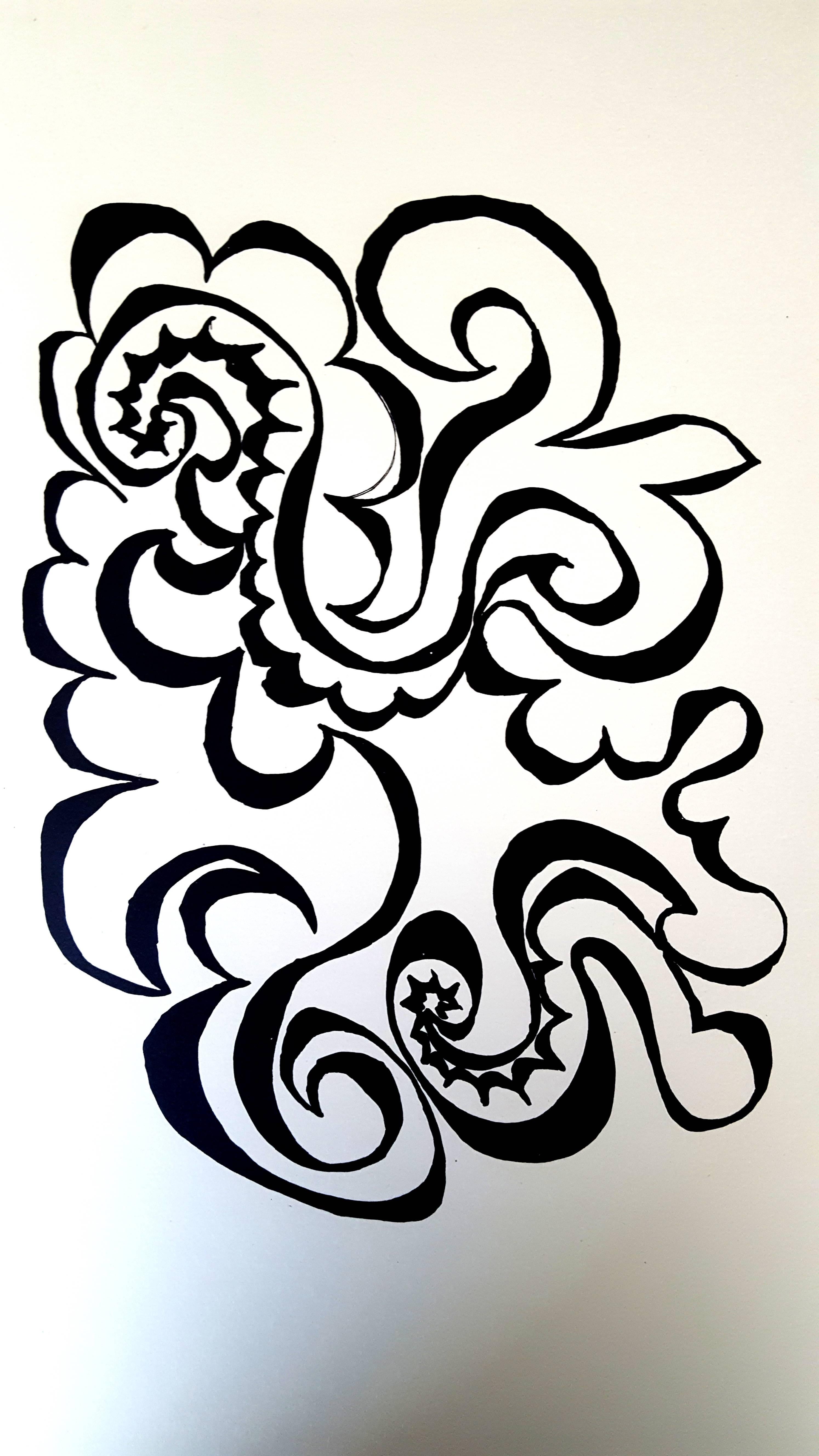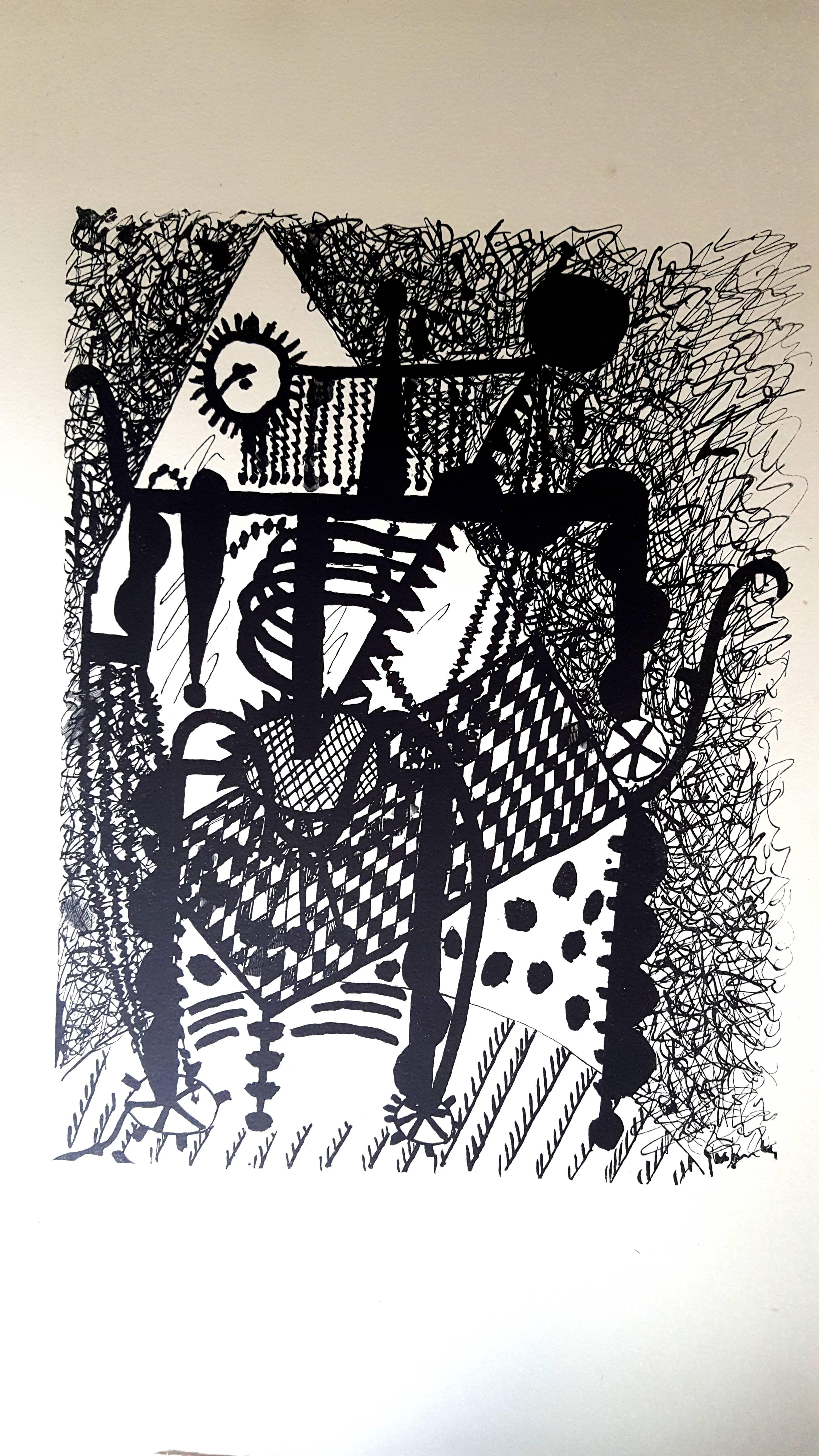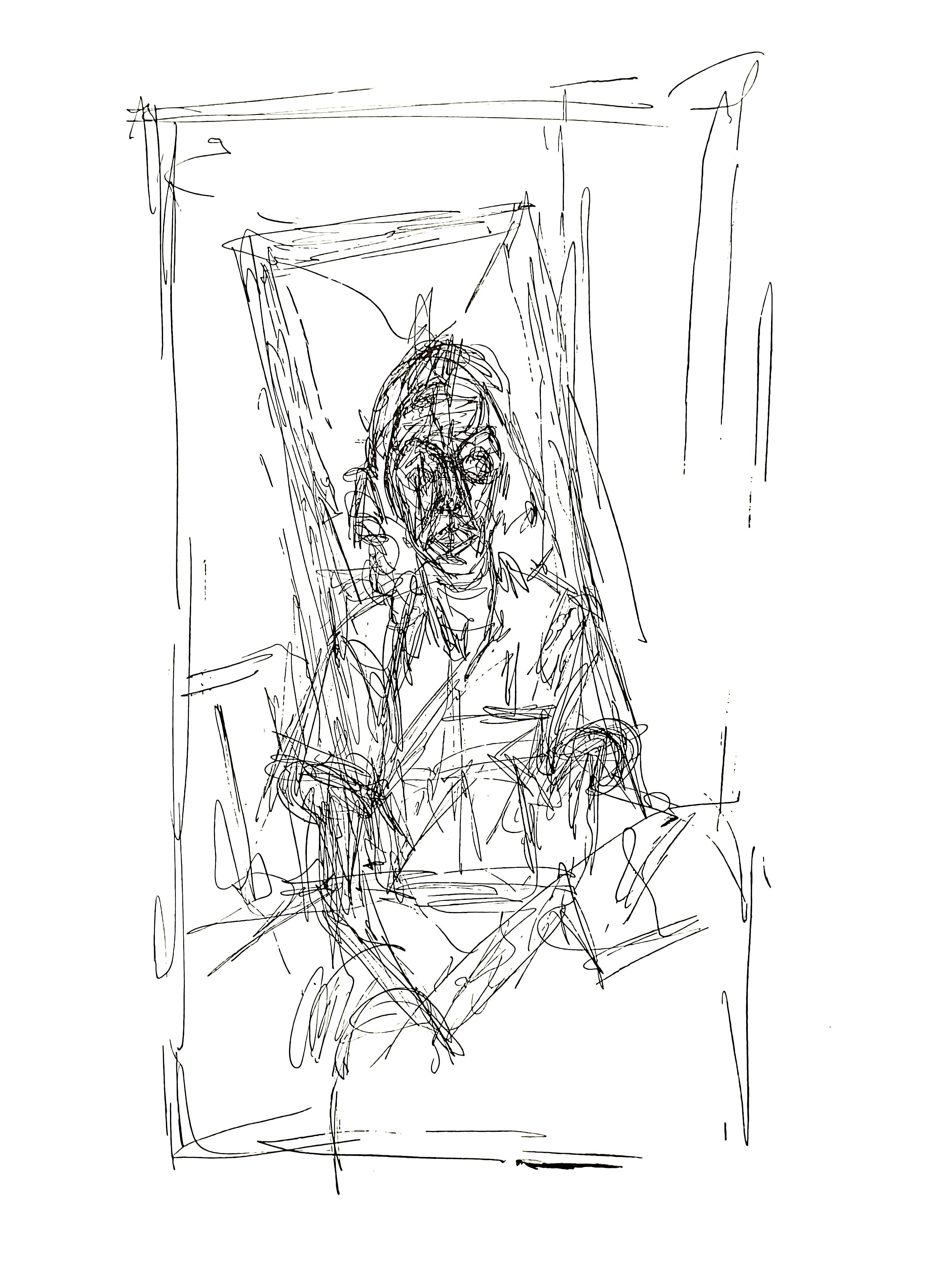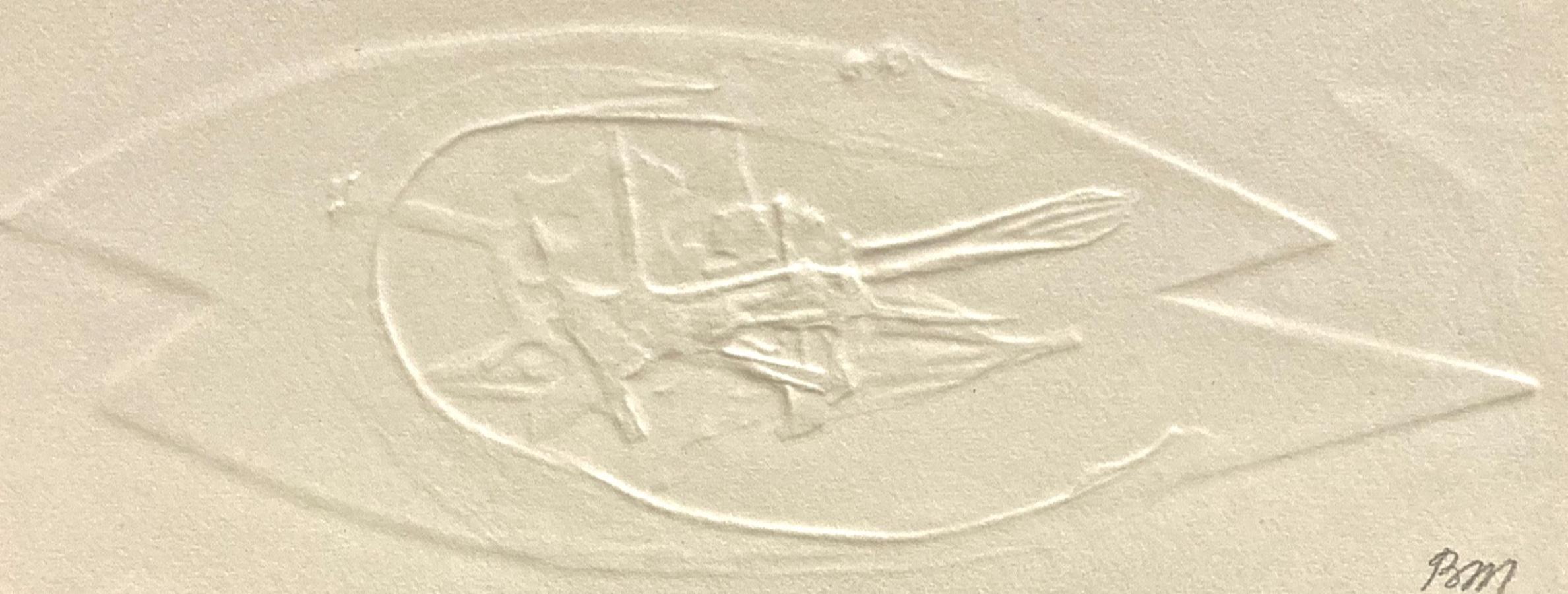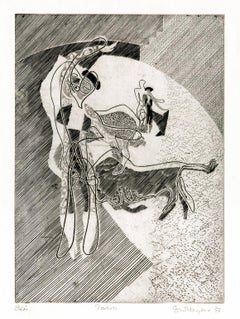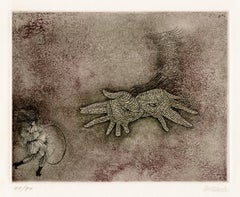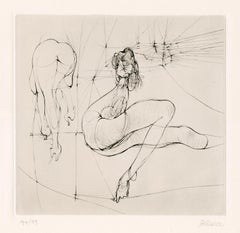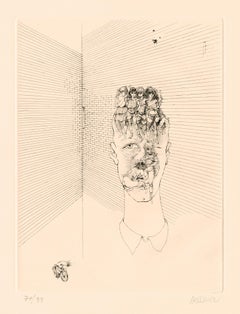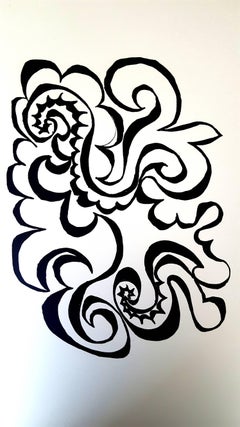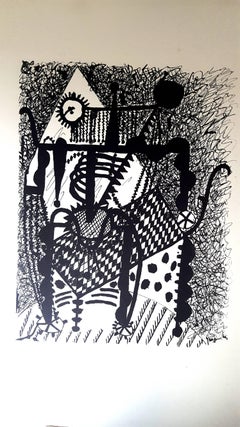Items Similar to 'Diptych' — Modernist Abstraction, Atelier 17
Want more images or videos?
Request additional images or videos from the seller
1 of 7
Stanley William Hayter'Diptych' — Modernist Abstraction, Atelier 171967
1967
About the Item
Stanley William Hayter, 'Diptych', color engraving and scorper, 1967, edition 50, Black & Moorhead 314. Signed, titled, dated, and numbered '10/50' in pencil. A superb, richly-inked impression, with fresh, vibrant colors on antique-white wove BFK Rives paper; the full sheet with margins (2 1/2 to 3 1/4 inches). Minor skinning and tape residue on the top and bottom sheet edges, verso, otherwise in excellent condition. Matted to museum standards, unframed.
Image size 13 7/8 x 19 1/2 inches (146 x 108 mm); sheet size 19 7/8 x 25 3/8 inches (394 x 292 mm).
Hayter created this work using engraving and scorper on 2 plates, printed side by side. He used alkali blue, printed intaglio, and a phthalo green with a hard roller on the surface. The proofing was in three states, the first with engraving (a single proof); the second adding further engraving and scorper (a single proof); the third added further engraving and editioned: color trial proofs, 5 artist's proofs, edition of 50. The edition was completed in three printings: 8 in 1967; then Hector Saunier printed numbers 9 through 18 in 1968, and numbers 19 through 50 in 1969. This impression is from the Saunier 1968 printing.
Note: the online image cannot accurately convey the vibrancy of the printed alkali blue/phthalo green.
ABOUT THE ARTIST
Stanley William Hayter (1901-1988) was a British painter and printmaker associated in the 1930s with Surrealism and from 1940 onward with Abstract Expressionism. Regarded as one of the most significant printmakers of the 20th century, Hayter founded the legendary Atelier 17 studio in Paris, now known as Atelier Contrepoint. Among the artists he is credited with influencing are Pablo Picasso, Alberto Giacometti, Joan Miró, Alexander Calder, and Marc Chagall.
The hallmark of the workshop was its egalitarian structure, breaking sharply with the traditional French engraving studios by insisting on a cooperative approach to labor and technical discoveries. In 1929 Hayter was introduced to Surrealism by Yves Tanguy and André Masson, who, with other Surrealists, worked with Hayter at Atelier 17. The often violent imagery of Hayter’s Surrealist period was stimulated in part by his passionate response to the Spanish Civil War and the rise of Fascism. He organized portfolios of graphic works to raise funds for the Spanish cause, including Solidarité (Paris, 1938), a portfolio of seven prints, one of them by Picasso. Hayter frequently exhibited with the Surrealists during the 1930s but left the movement when Paul Eluard was expelled. Eluard’s poem Facile Proie (1939) was written in response to a set of Hayter’s engravings. Other writers with whom Hayter collaborated in this way included Samuel Beckett and Georges Hugnet.
Hayter joined the exile of the Parisian avant-garde in 1939, moving with his second wife, the American sculptor Helen Phillips, to New York. He ran a course entitled ‘Atelier 17’ at the New School for Social Research until 1945 when he opened the workshop independently in Greenwich Village at 41 East 8th Street. Important figures in the emerging New York School associated with Hayter included Jackson Pollock, Robert Motherwell, Willem de Kooning, Mark Rothko, William Baziotes, and David Smith.
By 1946 Atelier 17 was operating independently in expanded and more versatile facilities. Engagements and temporary appointments kept Hayter traveling all over the country. In 1949 he published 'New Ways of Gravure', a book that included a short history of intaglio techniques and a description of the experiments and achievements of Atelier 17. In 1950 Hayter returned to Europe and reestablished Atelier 17 in Paris. Without him, the New York shop began a steady decline until its closing in 1955, whereas in Paris, the studio flourished.
Throughout the 1980s, Hayter continued to work with his customary drive and openness, consistently responding to currents of style and technique, eventually gravitating back to painting. In 1987, with the purchase of four hundred prints ranging in date from 1926 through 1960, the British Museum became the largest repository of Hayter’s work. When the artist died in London on May 4, 1988, work was underway on a major retrospective of his prints at the Ashmolean Museum at Oxford.
Hayter's graphic work is today included in almost every major 20th-century printmaking museum collection throughout the United States, the UK, and Europe, including The Art Institute of Chicago, Bibliothèque nationale de France (Paris), British Museum, Centre Pompidou (Paris), Harvard Art Museum, Hunterian Museum (University of Glasgow), Hyogo Prefectural Museum of Art (Kobe, Japan), Guggenheim Museum, Los Angeles County Museum of Art, Metropolitan Museum of Art, Museum of Fine Arts Boston, Museum of Modern Art, Musée d’Art Moderne de la Ville, (Paris), National Gallery of Art, Peggy Guggenheim Museum (Venice), Philadelphia Museum of Art, Royal Academy of Art (London), San Francisco Museum of Modern Art, Smithsonian American Art Museum, Tate Modern (London), Victoria & Albert Museum (London), Whitney Museum of American Art, Yale University Art Gallery.
- Creator:Stanley William Hayter (1901-1988, British)
- Creation Year:1967
- Dimensions:Height: 13.88 in (35.26 cm)Width: 19 in (48.26 cm)
- Medium:
- Movement & Style:
- Period:
- Condition:
- Gallery Location:Myrtle Beach, SC
- Reference Number:Seller: 1013511stDibs: LU532312419762
About the Seller
5.0
Recognized Seller
These prestigious sellers are industry leaders and represent the highest echelon for item quality and design.
Platinum Seller
Premium sellers with a 4.7+ rating and 24-hour response times
Established in 1995
1stDibs seller since 2016
297 sales on 1stDibs
Typical response time: 1 hour
Associations
International Fine Print Dealers Association
- ShippingRetrieving quote...Shipping from: Myrtle Beach, SC
- Return Policy
Authenticity Guarantee
In the unlikely event there’s an issue with an item’s authenticity, contact us within 1 year for a full refund. DetailsMoney-Back Guarantee
If your item is not as described, is damaged in transit, or does not arrive, contact us within 7 days for a full refund. Details24-Hour Cancellation
You have a 24-hour grace period in which to reconsider your purchase, with no questions asked.Vetted Professional Sellers
Our world-class sellers must adhere to strict standards for service and quality, maintaining the integrity of our listings.Price-Match Guarantee
If you find that a seller listed the same item for a lower price elsewhere, we’ll match it.Trusted Global Delivery
Our best-in-class carrier network provides specialized shipping options worldwide, including custom delivery.More From This Seller
View All'Torero' — rare, early modernist engraving – Atelier 17
By Stanley William Hayter
Located in Myrtle Beach, SC
Stanley William Hayter, 'Torero', engraving, 1932, edition 30, only 16 known impressions, trial proof, Black & Moorhead 71. Signed, titled, dated, and inscribed 'Essai' (test) in pencil. A superb impression with rich burr, on heavy BFK Rives cream, wove paper; full margins (2 1/4 to 6 1/4 inches). A short repaired tear (3/8 inch) in the left-center sheet edge, well away from the image; otherwise, in excellent condition. Scarce.
Image size 10 9/16 x 7 5/8 inches; sheet size 15 1/2 x 11 1/2 inches. Matted to museum standards, unframed.
ABOUT THE ARTIST
Stanley William Hayter (1901-1988) was a British painter and printmaker associated in the 1930s with Surrealism and from 1940 onward with Abstract Expressionism. Regarded as one of the most significant printmakers of the 20th century, Hayter founded the legendary Atelier 17...
Category
1930s Modern Abstract Prints
Materials
Engraving
'Child and Seeing Hands' — after the artist's 1948 Surrealist masterwork
By Hans Bellmer
Located in Myrtle Beach, SC
Hans Bellmer, 'Child and Seeing Hands', photogravure and engraving, edition 9, 1970. Flahutez 4-9. Signed by the artist and numbered '41/90' in pencil. A superb, richly-inked impress...
Category
1670s Surrealist Abstract Prints
Materials
Engraving, Photogravure
Untitled (Two Nudes) — Erotic Surrealism
By Hans Bellmer
Located in Myrtle Beach, SC
Hans Bellmer, Untitled (Two Nudes), engraving and drypoint, 1971, edition 99. Signed and numbered '94/99' in pencil. A fine impression, on Arches cream wove paper; the full sheet wit...
Category
1960s Surrealist Abstract Prints
Materials
Engraving, Drypoint
'Blue Eyes' — Erotic Surrealism
By Hans Bellmer
Located in Myrtle Beach, SC
Hans Bellmer, 'Blue Eyes', engraving and drypoint, edition 99, 1971. Flahutez 89. Signed and numbered '74/99' in pencil. A fine impression, on Arches cream wove paper; the full sheet...
Category
1960s Surrealist Abstract Prints
Materials
Engraving, Drypoint
'Feu sous L'eau' (Fire Under Water) —Mid-century Modernism, Atelier 17
By Stanley William Hayter
Located in Myrtle Beach, SC
Stanley William Hayter, 'Feu sous L'eau (Fire Under Water)', color engraving, soft-ground etching and scorper with yellow silkscreen, 1955, edition 50 plus 10 artist proofs, Black & Moorhead 221. Signed, titled 'Fire Under Water', dated and annotated 'Essai' in pencil. Dedicated in the artist’s hand 'for Adja & Dove WH Bill 17–5–55' in the top margin. A superb, richly inked impression with fresh colors, on heavy, cream wove paper; wide margins (2 1/2 to 3 7/8 inches), in excellent condition. One of 10 artist’s proofs. Image size 10 3/16 x 7 inches; sheet size 18 1/8 x 12 1/4 inches. Matted to museum standards, unframed.
ABOUT THIS WORK
In 1950 Hayter returned to Paris and reopened Atelier 17. Works such as 'Fire Under Water' reveal newfound influences, such as that of the Ardèche area of southern France, where he acquired a house in 1951 and frequently visited. Hayter took great interest in the flowing Escoutay River, an experience that parallels the artist and co-director of Atelier 17 Krishna Reddy’s interest in depicting water. While some forms in this print evoke the natural world, the palette of contrasting tones of purple, yellow, black, and white reflects Hayter’s belief in using color intuitively to express emotions and evoke feelings. The sharp white relief lines from the paper and the textural effects realized through soft-ground etching operate in tandem with the sweeping curves and bold colors to give the composition a sense of vitality and dynamism.
—edited from the Metropolitan Museum of Art
Published by 'La Jeune Gravure Contemporaine', Paris.
Impressions of this work are in the following collections: British Museum, Metropolitan Museum of Art, National Gallery of Art.
ABOUT THE ARTIST
Stanley William Hayter (1901-1988) was a British painter and printmaker associated in the 1930s with Surrealism and from 1940 onward with Abstract Expressionism. Regarded as one of the most significant printmakers of the 20th century, Hayter founded the legendary Atelier 17 studio in Paris, now known as Atelier Contrepoint. Among the artists he is credited with influencing are Pablo Picasso, Alberto Giacometti, Joan Miró, Alexander Calder, and Marc Chagall.
The hallmark of the workshop was its egalitarian structure, breaking sharply with the traditional French engraving studios by insisting on a cooperative approach to labor and technical discoveries. In 1929 Hayter was introduced to Surrealism by Yves Tanguy and André Masson, who, with other Surrealists, worked with Hayter at Atelier 17. The often violent imagery of Hayter’s Surrealist period was stimulated in part by his passionate response to the Spanish Civil War and the rise of Fascism. He organized portfolios of graphic works to raise funds for the Spanish cause, including Solidarité (Paris, 1938), a portfolio of seven prints, one of them by Picasso. Hayter frequently exhibited with the Surrealists during the 1930s but left the movement when Paul Eluard was expelled. Eluard’s poem Facile Proie (1939) was written in response to a set of Hayter’s engravings. Other writers with whom Hayter collaborated included Samuel Beckett and Georges Hugnet.
Hayter joined the exile of the Parisian avant-garde in 1939, moving with his second wife, the American sculptor Helen Phillips...
Category
1950s Abstract Expressionist Abstract Prints
Materials
Engraving, Etching
'European Landscape' —Mid-century American Surrealism
By Lawrence Kupferman
Located in Myrtle Beach, SC
Lawrence Kupferman, 'European Landscape', drypoint, edition 50, 1942. Signed, dated, titled, and numbered '7/50' in pencil. A superb, finely nuanced impression, on cream wove paper; the full sheet with margins (1 to 1 3/4 inches); in excellent condition.
Image size 10 7/8 x 13 3/8 inches; sheet size 13 1/8 x 16 1/2 inches. Archivally matted to museum standards, unframed.
An impression of this work is included in the permanent collection of the Syracuse University Art Museum.
ABOUT THE ARTIST
Lawrence Kupferman (1909 - 1982) was born in the Dorchester neighborhood of Boston and grew up in a working-class family. He attended the Boston Latin School and participated in the high school art program at the Museum of Fine Arts, Boston. In the late 1920s, he studied drawing under Philip Leslie Hale at the Museum School—an experience he called 'stultifying and repressive'. In 1932 he transferred to the Massachusetts College of Art, where he first met his wife, the artist Ruth Cobb. He returned briefly to the Museum School in 1946 to study with the influential expressionist German-American painter Karl Zerbe.
Kupferman held various jobs while pursuing his artistic career, including two years as a security guard at the Museum of Fine Arts, Boston. During the 1930s he worked as a drypoint etcher for the Federal Art Project, creating architectural drawings in a formally realistic style—these works are held in the collections of the Fogg Museum and the Smithsonian American Art Museum. In the 1940s he began incorporating more expressionistic forms into his paintings as he became progressively more concerned with abstraction. In 1946 he began spending summers in Provincetown, Massachusetts, where he met and was influenced by Mark Rothko, Hans Hofmann, Jackson Pollock, and other abstract painters. At about the same time he began exhibiting his work at the Boris Mirski Gallery in Boston.
In 1948, Kupferman was at the center of a controversy involving hundreds of Boston-area artists. In February of that year, the Boston Institute of Modern Art issued a manifesto titled 'Modern Art and the American Public' decrying 'the excesses of modern art,' and announced that it was changing its name to the Institute of Contemporary Art (ICA). The poorly conceived statement, intended to distinguish Boston's art scene from that of New York, was widely perceived as an attack on modernism. In protest, Boston artists such as Karl Zerbe, Jack Levine, and David Aronson formed the 'Modern Artists Group' and organized a mass meeting. On March 21, 300 artists, students, and other supporters met at the Old South Meeting House and demanded that the ICA retract its statement. Kupferman chaired the meeting and read this statement to the press:
“The recent manifesto of the Institute is a fatuous declaration which misinforms and misleads the public concerning the integrity and intention of the modern artist. By arrogating to itself the privilege of telling the artists what art should be, the Institute runs counter to the original purposes of this organization whose function was to encourage and to assimilate contemporary innovation.”
The other speakers were Karl Knaths...
Category
1940s Surrealist Abstract Prints
Materials
Drypoint
You May Also Like
Pablo Picasso (after) Helene Chez Archimede - Wood Engraving
By (after) Pablo Picasso
Located in Collonge Bellerive, Geneve, CH
Pablo Picasso (after)
Helene Chez Archimede
Medium: engraved on wood by Georges Aubert
Dimensions: 44 x 33 cm
Portfolio: Helen Chez Archimede
Year: 1955
Edition: 240 (Here it is on...
Category
1950s Modern Abstract Prints
Materials
Engraving
$837 Sale Price
20% Off
Pablo Picasso (after) Helene Chez Archimede - Wood Engraving
By (after) Pablo Picasso
Located in Collonge Bellerive, Geneve, CH
Pablo Picasso (after)
Helene Chez Archimede
Medium: engraved on wood by Georges Aubert
Dimensions: 44 x 33 cm
Portfolio: Helen Chez Archimede
Year: 1955
Edition: 240 (Here it is on...
Category
1950s Modern Figurative Prints
Materials
Engraving
$837 Sale Price
20% Off
Alberto Giacometti - Portrait
By Alberto Giacometti
Located in Collonge Bellerive, Geneve, CH
Alberto Giacometti - Portrait
Engraving (after the drawing)
Published in the deluxe art review, XXe Siecle
1956
Dimensions: 32 x 24 cm
Publisher: G. di San Lazzaro.
From the art Re...
Category
1950s Modern Abstract Prints
Materials
Engraving
Leonard Baskin Beautiful Abstracted Figure Wood Engraving
By Leonard Baskin
Located in New York, NY
Leonard Baskin (1922-2000)
Death of the Laureate, `1957
Wood Engraving
Framed: 18 1/2 x 18 in.
Signed and inscribed bottom: Death of the Laureate, Ed. 20, For Walter [Rosenblum], Leo...
Category
1950s American Modern Abstract Prints
Materials
Engraving
Boris Margo, Holiday Card (Peace and Joy), 1962
By Boris Margo
Located in New York, NY
Boris Margo is one of the artists whose work is instantly identified with 'Mid-century American Modernism.' Usually abstract with a spiky surrealist edge, it speaks to extensive inno...
Category
1960s American Modern Abstract Prints
Materials
Engraving
Red Loop (suite of 12 mezzotints in boxed portfolio)
By Eduardo Leyva Herrera
Located in New Orleans, LA
12 copper mezzotints printed on Hahnemulle paper in an edition of 12. This is impression #5
The 12 complementary mezzotints are included in boxed portfolio
Graduated from the Natio...
Category
21st Century and Contemporary Modern Still-life Prints
Materials
Mezzotint
Recently Viewed
View AllMore Ways To Browse
Antique Black And White Engravings
Royal Albert Plate
10mm David
Antique Set Of Color Engravings French
La Memoire Elementaire
La Morra
La Tirana
Le Pitre Rose
Leviathan Dali
Lewitt Scarf
Loretta Dunkelman
Louise Bourgeois Crochet
Lucio Pozzi On Sale
Luis Lopez Loza
Lydia Dona Print
Magie Eolienne
Maison Aurelien
Manabu Onogi
